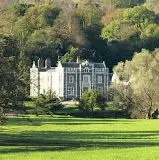Folkington Manor
Over 150 views on venues4hire.org

Folkington Manor - Folkington Manor
To make a booking or enquire about hiring this venue please use the contact details below - Please mention Venues for Hire
44 (0) 1323 483 946
Bookings Administrator
Use contact form below
Folkington Manor description
Wedding Venue
Medium (1-150)
The quiet lane to Folkington leads to a Grade 1 Listed church dedicated to St Peter, and onto the South Downs.
Folkington Manor was built in 1843 by the architect William John Donthorn (1799-1859), near the site of a manor that was recorded in the Domesday Book in 1086. In the 1240s, that house had passed on the marriage of the heiress Olympia de Folkington with Sir John de la Warre, Sheriff of Herefordshire, in whose family it descended until purchased by Sir Richard Sackville, known as Fill-Sack on account of his prodigious wealth, in 1543.
bible.jpg
st.peters.jpg
st.petersINT.jpg
The former house know as 'The Place'
FolkingtonPlace.jpg
Historical Photos of Folkington Manor-1.jpg
FM with Conservatory.jpg
James Gwynne & sons at Folkington Manor
James Gwynne on the front steps of Folkington Manor
Violet in Drawing room.jpg
Folkington Manor east front with a recently laid knot garden.
Violet Gordon Woodhouse.jpg
Eight years later, the bankruptcy of his great-grandson, the Second Earl of Dorset, brought about a forced sale for £2300 to a London merchant. The Place, as it was formerly called, was held on a long lease by the Culpeper family. In 1652, just after the lease expired, Folkington was purchased by Sir William Thomas, and was one of only three houses in Sussex to be depicted in the fashionable Britannia Illustrata of 1707, the year after it had been inherited by William Dobell.
The old house was largely demolished in about 1820. In 1840 Folkington, together with the manor house at nearby Wootton, were bought by Thomas Sheppard, M.P. for Frome, who three years later built the present manor at a new site slightly to the north of the church. Folkington Place, the remnants of the original building on the manorial site, retains some architectural elements of the ancient home of the Sackvilles, Culpeppers, Thomases and Dobells.
After the death of Thomas Sheppard’s son in 1875 both properties were sold to Mr James Gwynne, an engineer and antiquary, and in 1915 passed to his son Col. Rupert Gwynne, M.P. for Eastbourne between 1910 and 1924. Rupert Gwynne was father of Elizabeth David, the pre-eminent British cookery writer of the mid-20th century, and brother of Violet Gordon Woodhouse, the influential and highly acclaimed musician. On his death the house passed into the hands of his younger brother Sir Roland Gwynne, Mayor of Eastbourne 1928-31.
As noted in a Country Life editorial in 1958, Folkington has long had a close connection with the arts, a tradition that continues to this day.
Ronald Stacy-Marks purchased the house and relatively a few acres in 1968. An initial restoration was undertaken after the property had been empty for five years.
The Flint Rooms were at the core of the families well-respected fine-art business with the Manor containing a number of galleries suitable for displaying large amounts of fine art. Adam Stacy-Marks took over the family business in 1987 increasing and completeting the current estate.
Folkington Manor was built in 1843 by the architect William John Donthorn (1799-1859), near the site of a manor that was recorded in the Domesday Book in 1086. In the 1240s, that house had passed on the marriage of the heiress Olympia de Folkington with Sir John de la Warre, Sheriff of Herefordshire, in whose family it descended until purchased by Sir Richard Sackville, known as Fill-Sack on account of his prodigious wealth, in 1543.
bible.jpg
st.peters.jpg
st.petersINT.jpg
The former house know as 'The Place'
FolkingtonPlace.jpg
Historical Photos of Folkington Manor-1.jpg
FM with Conservatory.jpg
James Gwynne & sons at Folkington Manor
James Gwynne on the front steps of Folkington Manor
Violet in Drawing room.jpg
Folkington Manor east front with a recently laid knot garden.
Violet Gordon Woodhouse.jpg
Eight years later, the bankruptcy of his great-grandson, the Second Earl of Dorset, brought about a forced sale for £2300 to a London merchant. The Place, as it was formerly called, was held on a long lease by the Culpeper family. In 1652, just after the lease expired, Folkington was purchased by Sir William Thomas, and was one of only three houses in Sussex to be depicted in the fashionable Britannia Illustrata of 1707, the year after it had been inherited by William Dobell.
The old house was largely demolished in about 1820. In 1840 Folkington, together with the manor house at nearby Wootton, were bought by Thomas Sheppard, M.P. for Frome, who three years later built the present manor at a new site slightly to the north of the church. Folkington Place, the remnants of the original building on the manorial site, retains some architectural elements of the ancient home of the Sackvilles, Culpeppers, Thomases and Dobells.
After the death of Thomas Sheppard’s son in 1875 both properties were sold to Mr James Gwynne, an engineer and antiquary, and in 1915 passed to his son Col. Rupert Gwynne, M.P. for Eastbourne between 1910 and 1924. Rupert Gwynne was father of Elizabeth David, the pre-eminent British cookery writer of the mid-20th century, and brother of Violet Gordon Woodhouse, the influential and highly acclaimed musician. On his death the house passed into the hands of his younger brother Sir Roland Gwynne, Mayor of Eastbourne 1928-31.
As noted in a Country Life editorial in 1958, Folkington has long had a close connection with the arts, a tradition that continues to this day.
Ronald Stacy-Marks purchased the house and relatively a few acres in 1968. An initial restoration was undertaken after the property had been empty for five years.
The Flint Rooms were at the core of the families well-respected fine-art business with the Manor containing a number of galleries suitable for displaying large amounts of fine art. Adam Stacy-Marks took over the family business in 1987 increasing and completeting the current estate.
Venue suitability
This venue is suitable for the following uses:
Venue facilities
Other venue facilities
We don't currently hold any detailed information about the rooms at this Venue.
If this is your Venue or Hall please use the Adopt link on the right to add more detailed information about this Venue.
If you wish to hire this Venue or Hall please use the contact details on the overview tab.
Please encourage every Venue to take a few minutes to 'Adopt' their listing and add unique content and photos.
